电弧熔炼法合成掺锡AlCrFeNiMn高熵合金的腐蚀性能
Q1 Materials Science
引用次数: 0
摘要
摘要在工程应用过程中,钢材等材料的失效会造成经济损失;因此,开发新的耐腐蚀材料至关重要。本研究利用Al、Cr、Fe、Mn和Ni的高级粉末合成了具有潜在化学工业应用前景的等摩尔AlCrFeNiMn高熵合金(HEA)。添加1at%、3at%和5at%的锡(Sn)作为合金添加剂,进一步改变了铸造合金的性能。为了评估Sn对合金耐蚀性的影响,在不同的酸性和碱性环境下进行了动电位极化试验。采用扫描电子显微镜(SEM)、光学显微镜(OPM)、x射线衍射仪(XRD)和能量色散x射线能谱仪(EDS)等多种表面检测技术对合金腐蚀后的形态变化和元素组成进行了检测。采用纳米压痕机对材料的纳米硬度进行了分析。TGA分析还确定了Sn添加对AlCrFeNiMn HEA热稳定性的影响。在0.5 M HCl溶液中,掺锡合金表现出良好的耐蚀性。另一方面,它们暴露在0.5 mol/L的h2so4溶液中,发现对它们的电化学稳定性有害。在0.5 M h2so4溶液中,发现5在% sn掺杂的样品的失重量大大降低。所有样品的质量在3.5 wt% NaOH溶液中保持不变。本文章由计算机程序翻译,如有差异,请以英文原文为准。
Corrosion Performance of Sn-Doped AlCrFeNiMn High-Entropy Alloy Synthesized via Arc-Melting Technique
Abstract Failure of materials such as steels during engineering applications can result in economic harm; hence, developing new corrosion-resistant materials is critical. In this work, high-grade powders of Al, Cr, Fe, Mn, and Ni were used to synthesize an equimolar AlCrFeNiMn high-entropy alloy (HEA) for potential chemical industry application. The cast alloy's properties were further altered by the addition of 1at%, 3at%, and 5at% tin (Sn) as alloying additives. To assess the impact of Sn on the alloy's resistance to corrosion, potentiodynamic polarization tests were conducted in various acidic and basic environments. Several surface inspection techniques, including scanning electron microscopy (SEM), optical microscopy (OPM), X-ray diffractrometry (XRD), and energy-dispersive X-ray spectroscopy (EDS), were employed to examine the morphological changes and elemental composition of the alloy after it was subjected to corrosive conditions. The nano-indentation machine was used to analyze the materials' nanohardness. TGA analysis was also performed to determine how Sn additions affected the AlCrFeNiMn HEA’s thermal stability. In 0.5 M HCl solution, the Sn-doped alloys demonstrated good corrosion resistance. Their exposure to 0.5 mol/L H 2 SO 4 solution, on the other hand, found to be deleterious to their electrochemical stability. The weight loss of 5 at% Sn-doped samples in 0.5 M H 2 SO 4 solution was found to be substantially reduced. The mass of all the samples stayed constant in 3.5 wt% NaOH solution.
求助全文
通过发布文献求助,成功后即可免费获取论文全文。
去求助
来源期刊

Journal of Bio- and Tribo-Corrosion
Materials Science-Metals and Alloys
CiteScore
6.10
自引率
0.00%
发文量
101
期刊介绍:
The Journal of Bio- and Tribo-Corrosion publishes papers in all aspects of tribo-corrosion, ranging from biological environments to green energy technologies to bio-degradable metals and polymer composites. Rigorously reviewed research papers and reviews in the journal cover a broad range of subjects such as corrosion, tribo-corrosion of coatings and thin films, sliding-corrosion, fretting-corrosion, microabrasion-corrosion, tribo-corrosion models, bio-tribo-corrosion, surface engineering and materials, nano-corrosion, and surface modifications (nanotube and texturing) to improve tribocorrosion resistance by keeping biocompactability and cell viability. Specific topics include: Sliding wear, abrasion (including micro-abrasion), erosion, fretting, and fatigue interactions with corrosion Models and mechanistic maps Biological processes such as hip and knee joint wear, wear of dental materials, and wear of artificial heart vales Renewable technologies, such as wave, wind (including offshore), and tidal power Conventional energy, including nuclear, oil and gas, and combined cycle coal conversion Lubricants and tribo-corrosion interactions with lubrication, including bio-oils Case studies and rapid communications on hot topics.
 求助内容:
求助内容: 应助结果提醒方式:
应助结果提醒方式:


